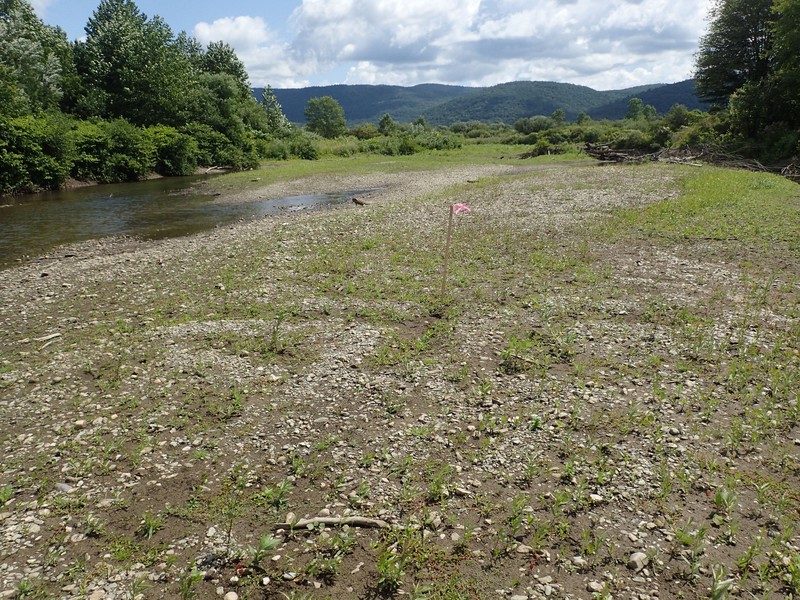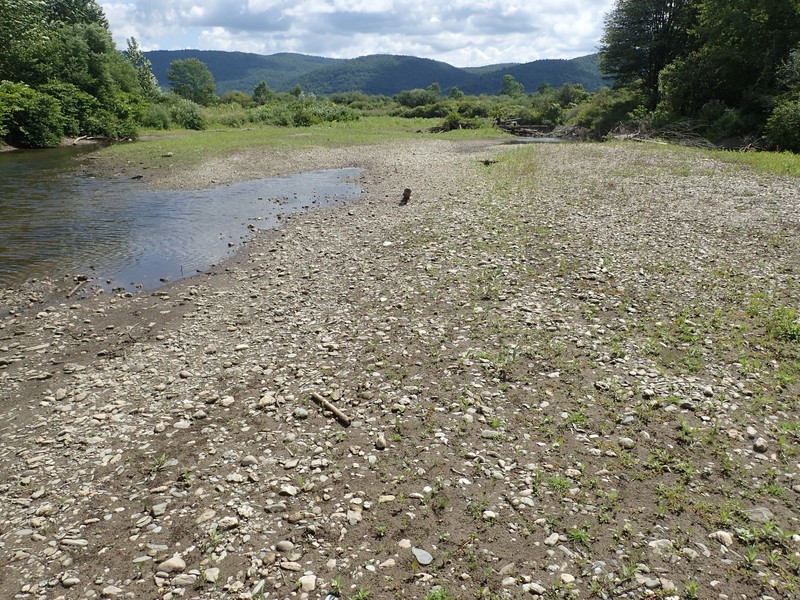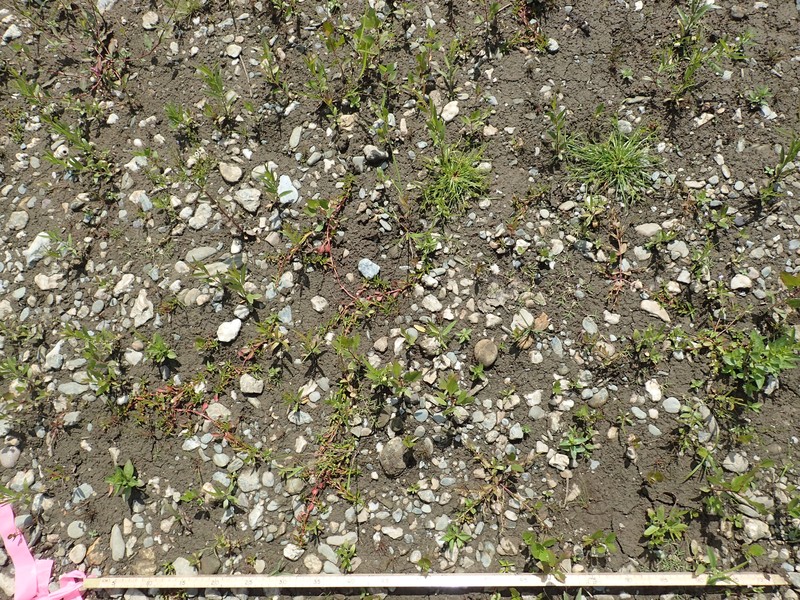Riverside Sand/Gravel Bar
- System
- Terrestrial
- Subsystem
- Open Uplands
- State Protection
- Not Listed
Not listed or protected by New York State.
- Federal Protection
- Not Listed
- State Conservation Status Rank
- S3S4
Vulnerable in New York, or Apparently Secure - Vulnerable to disappearing from New York (but not currently imperiled), with relatively few populations or locations, few individuals, and/or restricted range; or uncommon but not rare in New York; may be rare in some parts of the state; possibly some cause for long-term concern due to declines or other factors. More information is needed to assign either S3 or S4.
- Global Conservation Status Rank
- G5
Secure globally - Common in the world; widespread and abundant (but may be rare in some parts of its range).
Summary
Did you know?
Riverside sand and gravel bars provide favorable habitat for certain rare plants, such as swordleaf rush (Juncus ensifolius), dwarf bulrush (Lipocarpha micrantha), Carey's smartweed (Persicaria careyi), and low sand cherry (Prunus pumila var. depressa). However, these habitats are subject to multiple natural and human disturbances, making them particularly vulnerable to invasion by exotic plant species, such as Japanese knotweed (Reynoutria japonica var. japonica) and purple loosestrife (Lythrum salicaria). Ice scour and spring flooding from snow melt are natural processes that contribute to the dynamic nature of the plant communities and the substrate of riverside sand and gravel bars. In addition, artificial water-level fluctuation through the regulation of dams and reservoirs can influence these communities and the organisms that inhabit them.
State Ranking Justification
There are probably several hundred occurrences statewide. A few documented occurrences have good viability and several are protected on public land or private conservation land. This community is limited to the rivers and streams with sand or gravel substrate in the state, and there are only a few high quality examples. The current trend of this community is probably stable for occurrences on public land, or declining slightly elsewhere due to moderate threats that include alteration to hydrology, shoreline development, instream gravel mining, and invasive species.
Short-term Trends
The number and acreage of riverside sand/gravel bars in New York have probably declined slightly in recent decades as a result of shoreline development, alteration to the hydrology, instream gravel mining, and invasive species.
Long-term Trends
The number and acreage of riverside sand/gravel bars in New York have probably declined moderately from historical numbers likely correlated to the alteration of natural hydrology from impoundments, shoreline hardening, and instream gravel mining.
Conservation and Management
Threats
Riverside sand/gravel bars are threatened by development (e.g., residential, agricultural, industrial) in the surrounding landscape. Structures built along the shoreline (e.g., riprap, boat launches) are a particular threat to this community. Other threats include habitat alteration (e.g., instream gravel mining, road crossings, logging in adjacent floodplain), and relatively minor recreational overuse (e.g., boating, ATVs, trampling by visitors, fishing, trash dumping). Threats to rivers may apply to the riverside sand/gravel bars (e.g., pollution, nutrient loading, sedimentation, impoundments, flooding, water release for rafting). Several riverside sand/gravel bars are threatened by non-native species.
Conservation Strategies and Management Practices
Where practical, establish and maintain a natural riparian buffer to reduce storm-water, pollution, and nutrient run-off, while simultaneously capturing sediments before they reach the riverside sand/gravel bar. Avoid habitat alteration along the shoreline and surrounding landscape. Restore riverside sand/gravel bars that have been affected by unnatural disturbance (e.g., remove obsolete impoundments in order to restore the natural hydrology). Reduce or eliminate instream gravel mining from the best examples of riverside sand/gravel bar. Prevent the spread of invasive exotic species into the riverside sand/gravel bars through appropriate direct management, and by minimizing potential dispersal corridors, such as roads and bridges. Maintain or restore the natural flood and ice scour regime.
Development and Mitigation Considerations
Where practical, establish and maintain a natural riparian buffer to filter storm-water, pollution, and nutrient run-off from surrounding uplands and to capture sediments before they reach the riverside sand/gravel bar. Avoid habitat alteration along the shoreline and surrounding landscape. Minimize potential dispersal corridors for exotic species, such as roads and bridges. Maintain or restore the natural flood and ice scour regime.
Inventory Needs
Survey for occurrences statewide to advance documentation and classification of riverside sand/gravel bars. Continue searching for large sites in good condition (A- to AB-ranked).
Research Needs
Research composition of riverside sand/gravel bars statewide in order to characterize variations and to clearly separate this community from cobble shore and cobble shore wet meadow.
Rare Species
- Carex emoryi (Emory's Sedge) (guide)
- Cicindela ancocisconensis (Appalachian Tiger Beetle) (guide)
- Cicindela marginipennis (Cobblestone Tiger Beetle) (guide)
- Cornus drummondii (Rough-leaved Dogwood) (guide)
- Cyperus subsquarrosus (Small-flowered Dwarf Bulrush) (guide)
- Equisetum pratense (Meadow Horsetail) (guide)
- Juniperus horizontalis (Creeping Juniper) (guide)
- Lampsilis cariosa (Yellow Lampmussel) (guide)
- Ligumia nasuta (Eastern Pondmussel) (guide)
- Myriophyllum pinnatum (Cut-leaved Water Milfoil) (guide)
- Polygonum buxiforme (American Knotweed) (guide)
- Progomphus obscurus (Common Sanddragon) (guide)
- Prunus pumila var. depressa (Dwarf Cherry) (guide)
- Solidago ohioensis (Ohio Goldenrod) (guide)
Range
New York State Distribution
Riverside sand/gravel bars are widespread throughout New York State. They are probably represented by different regional variants.
Global Distribution
This physically broadly-defined community may be worldwide. Examples with the greatest biotic affinities to New York occurrences are suspected to span north to southern Canada, west to Minnesota, southwest to Indiana and Tennessee, southeast to Georgia, and northeast to Nova Scotia.
Best Places to See
- Zoar Valley Multiple Use Area
- Batten Kill (Washington County)
Identification Comments
General Description
A meadow community that occurs on sand and gravel bars deposited within, or adjacent to, a river channel. The community can manifest in a variety of ways depending on rates of deposition and erosion of the sand or gravel substrate. Physiognomic variants include very sparse vegetation, tall or short herbs, dwarf shrubland, shrubland, or sparse woodland (Edinger et al. 2002).
Characters Most Useful for Identification
Riverside sand/gravel bars can be found along streams throughout New York State. This community is identified by shoreline environments consisting of exposed, well-drained bars composed of sand and gravel (particles smaller than 10 cm in diameter). While the ratio of sand to gravel certainly varies from one occurrence to the next, a common proportion is roughly 70% sand to 30% gravel.
Elevation Range
Known examples of this community have been found at elevations between 98 feet and 1,500 feet.
Best Time to See
While this community can be indentified anytime during the snow-free seasons, it is most enjoyable to visit during the growing season, from late May through summer, when plants are flowering and water temperatures are conducive to wading.
Riverside Sand/Gravel Bar Images
Classification
International Vegetation Classification Associations
This New York natural community encompasses all or part of the concept of the following International Vegetation Classification (IVC) natural community associations. These are often described at finer resolution than New York's natural communities. The IVC is developed and maintained by NatureServe.
- Twisted Sedge - Indian-hemp - Flatsedge species Riverbed Vegetation (CEGL006536)
- Laurentian Cobble-Gravel Rivershore Vegetation (CEGL002304)
- Black Willow - Willow species / Twisted Sedge - Indian-Hemp Wet Shrubland (CEGL006065)
NatureServe Ecological Systems
This New York natural community falls into the following ecological system(s). Ecological systems are often described at a coarser resolution than New York's natural communities and tend to represent clusters of associations found in similar environments. The ecological systems project is developed and maintained by NatureServe.
- Central Appalachian Stream and Riparian (CES202.609)
- Laurentian-Acadian Floodplain Forest (CES201.587)
- Laurentian-Acadian Wet Meadow-Shrub Swamp (CES201.582)
Characteristic Species
-
Trees > 5m
- Acer saccharum (sugar maple)
-
Shrubs 2 - 5m
- Platanus occidentalis (eastern sycamore)
- Populus deltoides ssp. deltoides (eastern cottonwood)
- Salix interior (sandbar willow)
-
Shrubs < 2m
- Platanus occidentalis (eastern sycamore)
- Populus deltoides ssp. deltoides (eastern cottonwood)
- Prunus pumila var. depressa (dwarf cherry)
- Salix interior (sandbar willow)
-
Vines
- Clematis virginiana (virgin's-bower)
-
Herbs
- Apocynum cannabinum (Indian-hemp)
- Bidens frondosa (devil's beggar-ticks)
- Calamagrostis canadensis var. canadensis (Canada bluejoint grass)
- Daucus carota (wild carrot)
- Doellingeria umbellata var. umbellata (tall flat-topped white-aster)
- Dryopteris intermedia (evergreen wood fern, fancy wood fern, common wood fern)
- Eupatorium perfoliatum (boneset)
- Eutrochium maculatum var. maculatum (spotted Joe-Pye-weed)
- Lycopus americanus (American bugleweed, American water-horehound)
- Lythrum salicaria (purple loosestrife)
- Matteuccia struthiopteris var. pensylvanica (ostrich fern)
- Melilotus officinalis (yellow sweet-clover)
- Panicum capillare ssp. capillare (common witch grass)
- Solidago gigantea (swamp goldenrod)
- Veratrum viride (false hellebore, Indian corn lily)
- Xanthium strumarium var. strumarium (European cocklebur)
Similar Ecological Communities
- Calcareous shoreline outcrop
(guide)
Calcareous shoreline outcrops are on calcareous rocks such as limestone and dolomite. Whereas, riverside sand/gravel bars are on unconsolidated sand and gravel.
- Cobble shore
(guide)
Cobble shore communities occur on well-drained cobbles, rocks that range from 10 to 25 cm in diameter. The smaller particles composing sand/gravel bars are usually much less than 10 cm in diameter.
- Cobble shore wet meadow
(guide)
Riverside sand/gravel bars are terrestrial communities that occurs on well-drained sand and gravel bars deposited within, or adjacent to, a river channel. Whereas, the soil underlying cobble shore wet meadows is hydric and the vegetation is predominately hydrophytic.
- Riverside ice meadow
(guide)
Riverside ice meadows occur on gently sloping cobble substrates and bedrock outcrops along large rivers in areas where winter ice floes are pushed up onto the shore, forming an ice pack that remains until late spring. Such unique ice dynamics are absent from riverside sand/gravel bar communities.
- Shoreline outcrop
(guide)
Shoreline outcrops are on bedrock outcrops of non-calcareous rocks such as anorthosite, granite, quartzite, sandstone, gneiss, or schist. Whereas, riverside sand/gravel bars are on unconsolidated sand and gravel.
Vegetation
Percent cover
This figure helps visualize the structure and "look" or "feel" of a typical Riverside Sand/Gravel Bar. Each bar represents the amount of "coverage" for all the species growing at that height. Because layers overlap (shrubs may grow under trees, for example), the shaded regions can add up to more than 100%.
Additional Resources
References
Edinger, G. J., D. J. Evans, S. Gebauer, T. G. Howard, D. M. Hunt, and A. M. Olivero (editors). 2014. Ecological Communities of New York State. Second Edition. A revised and expanded edition of Carol Reschke’s Ecological Communities of New York State. New York Natural Heritage Program, New York State Department of Environmental Conservation, Albany, NY. https://www.nynhp.org/ecological-communities/
Edinger, Gregory J., D.J. Evans, Shane Gebauer, Timothy G. Howard, David M. Hunt, and Adele M. Olivero (editors). 2002. Ecological Communities of New York State. Second Edition. A revised and expanded edition of Carol Reschke's Ecological Communities of New York State. (Draft for review). New York Natural Heritage Program, New York State Department of Environmental Conservation. Albany, NY. 136 pp.
New York Natural Heritage Program. 2024. New York Natural Heritage Program Databases. Albany, NY.
Reschke, Carol. 1990. Ecological communities of New York State. New York Natural Heritage Program, New York State Department of Environmental Conservation. Latham, NY. 96 pp. plus xi.
Links
About This Guide
This guide was authored by: Aissa Feldmann
Information for this guide was last updated on: November 13, 2023
Please cite this page as:
New York Natural Heritage Program. 2024.
Online Conservation Guide for
Riverside sand/gravel bar.
Available from: https://guides.nynhp.org/riverside-sandgravel-bar/.
Accessed July 27, 2024.


